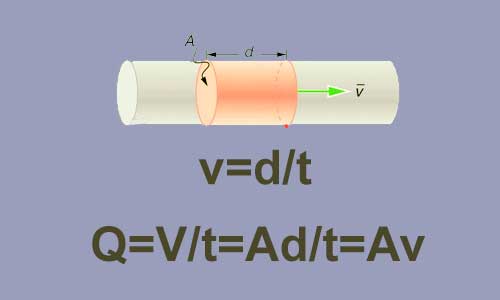Flow Rate (Volume Flow Rate, Mass Flow Rate)
Flow is the movement of materials such as liquid, gas and solids in industrial settings. To control the processes and automating the movements of machines, flow is one of the most important physical quantities that should be measured and controlled.
Flow Rate
Flow rate (Q) refers to the volume of fluid (V) that passes through an area during a period of time (t).
Its formula is defined as follows:
Q=V/t
(In this formula, V means volume, t means time, and Q is flow rate).

Flow rate units:
m3/s is the SI unit for Flow rate. But Q also has other units that will be mentioned below.
Example for flow rate:
The heart of an adult human at rest pumps blood at a rate of 5.00 liters per minute (L/min). A liter is 1/1000 cubic meters or 1000 cubic centimeters (10-3 m3 or 103 cm3).
Q also has other units:
- CFM (cubic feet per minute)
- SCFM (Standard Cubic Feet per Minute) at STP condition
- ACFM (Actual Cubic Feet per Minute); it is the actual flow at the operating temperature and pressure conditions.
- Am³/hr (Actual Cubic Meter per hour); it is the actual flow at the operating temperature and pressure conditions.
- Nm³/hr (Normal Cubic Meter per hour); it is the normalized value of flow at NTP conditions.
i.e. flow at Normal Temperature 0º C and Normal Pressure 101.32 kPa condition.
Note: STP/NTP conditions are decided by different authorities/ organizations as per their specifications.
Volume Flow Rate
Volume flow rate is defined as the volume of fluid that passes a measurement point during a specified period of time.
The volume rate can be calculated if inside pipe diameter and the average flow velocity is available.
Q= A x v
Q = volumetric flow rate
A = Cross sectional area of the pipe
v = average flow velocity
Units for volumetric flow rate:
The SI unit is cubic meters per second (m3/s).
Other units for volumetric flow rate:
- Standard cubic centimeters per minute (SCCM)
- Cubic feet per second (ft3/s) (US customary and imperial units)
- Gallons per minute (GPM) (US customary and imperial units)
Mass Flow Rate
Mass flow rate is defined as the amount of mass passing a specific point during a specified period of time.
This parameter is used to measure the mass or weight of a substance in a flow process operation. Mass flow rate formula is as follows:
W = Q x r
(W means mass flow rate, Q means volumetric flow rate and r means density).
Mass flow rate unit in the SI unit is kilogram per second (kg/s). In addition, its unit in US customary units is the slug per second (Slug/s) or pound per second (lb/s).
Tap here to get more information about Flow Meters:
Flow meter (Working Principle, Different Types and FAQs)
Flow Meter Vs. Flow Transmitter Vs. Flow Switch
Recent Posts
-
Booster Pump Troubleshooting and Maintenance: How to Fix and Prevent Common Issues
1. Introduction Imagine turning on your faucet only to be greeted with a weak trickle of water when …22nd Apr 2025 -
Energy-Efficient Booster Pumps: Selection and Tips for Maximizing Performance
1. Introduction Imagine never having to deal with fluctuating water pressure, noisy pumps, or skyroc …19th Apr 2025 -
Booster Pumps for Sustainable Water Systems: Irrigation and Rainwater Harvesting Solutions
1. Introduction Water scarcity is no longer a distant threat—it’s a reality affecti …16th Apr 2025




